Archive for the ‘Chelsea Flower Show’ Category
Chelsea Flower Show Part 3: My Favorite Gardens
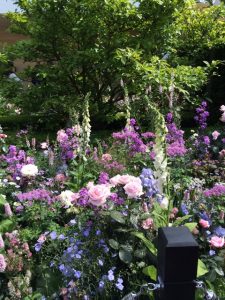 The Chelsea garden themes were as varied as the riots of color and different plants displayed: historic gardens, commemorative gardens (for the Queen’s 90th birthday), squares of different plants of matching colors, and squares of similar plants of different colors – roses, orchids, tulips – it went on and on. Then there were wilder plantings, like woodland meadows. Some were unique – an old mill next to a stream with a bucket of colored wool spilling out, surrounded by plants for dyeing.
The Chelsea garden themes were as varied as the riots of color and different plants displayed: historic gardens, commemorative gardens (for the Queen’s 90th birthday), squares of different plants of matching colors, and squares of similar plants of different colors – roses, orchids, tulips – it went on and on. Then there were wilder plantings, like woodland meadows. Some were unique – an old mill next to a stream with a bucket of colored wool spilling out, surrounded by plants for dyeing.My favorites were the St. John’s Hospice Garden – “A Modern Apothecary,” and the LG “Smart Garden” – both filled with flowering plants of pink and purple pastel hues. I was not alone – both gardens had won Silver-Gilt Medals from the Royal Horticultural Society. Both were meant as tranquil places, and each also had a second theme – the Smart Garden merged modern technology with the natural environment, and every element in the Modern Apothecary garden had been shown to have some beneficial effect on healing.
As its name suggests, the Apothecary Garden contained herbs and plants used for their medicinal properties – fragrant purple-flowered rosemary, lavender, and thyme; daisy-like flowers of feverfew, white flowering hawthorne, golden marigold, and delicate blue flowered flax.
The layout too, and architectural elements also had healing aspects. A pale pink climbing rose trellis arch marked the entrance to the garden. In an alcove adorning the back of the garden stood a bronze statue of a snake winding around the staff of Aesclepius – the universal symbol of healing and medicine. 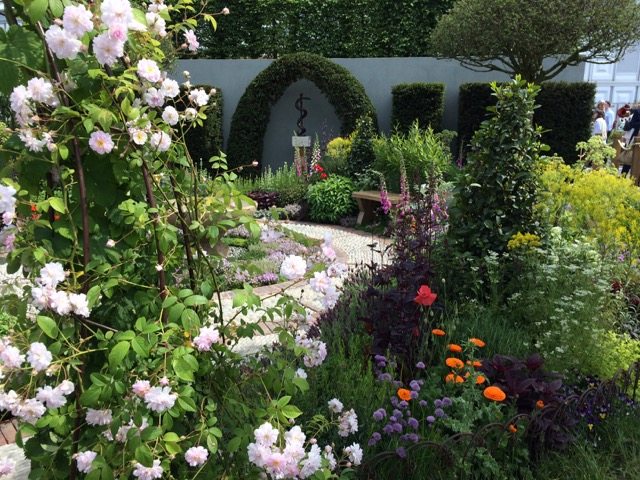 Connecting the two was a brick paved path lined with a few oak benches.
Connecting the two was a brick paved path lined with a few oak benches.
This garden’s layout – an entrance arch, a focal point (the statue), a path, a place to sit, is one that is used in all the sacred, healing gardens created by the TKF Foundation: an Annapolis, Maryland-based non-profit dedicated to creating healing, sacred gardens throughout the US. The arch defines the space, and helps keep it sacred. The focal point draws you towards it and guides your meanderings along the paths, in quiet meditation.
The places to sit also provide an opportunity for quiet contemplation. The TKF Foundation’s signature benches, placed in all their sacred spaces, are large semi-circular oak, made from oak barrels that Founder and CEO Tom Stoner had purchased from a defunct brewery. He simply cut the large barrels in half and re-assembled them to make the benches. Under each bench is placed a waterproof notebook where visitors can record their thoughts. The “Green Road” healing forest glen at the Walter Reed National Medical Center in Bethesda, Maryland, currently under construction in partnership with the TKF Foundation, will have these features too.
I have always found gardens to be my sanctuary, my places of peace – places I escape to when I am stressed or distressed. Some of my favorites, which I describe in Healing Spaces, are the Bishop’s Garden at the National Cathedral in Washington, DC; the Huntington Gardens in LA; and a lovely mature Japanese garden on the roof of a hotel in downtown LA’s ‘Little Tokyo.’ You would never guess that the tall trees that shade an azalea-lined stream and the high waterfall splashing into a pebble beach, all sit atop the third floor of a convention space attached to the hotel. All these gardens have the same features, on different scales – an entrance-way, a winding path, and benches on which to sit, and many have water elements.
Perhaps my love of gardens comes from my mother – although I didn’t inherit her love of gardening. I would rather enjoy the fruits of someone else’s labors. My mother tended our garden in Montreal with love and dedication, rejoicing in the young shoots that pushed up through the dry leaves and melting snow in early spring, welcoming the spring and summer rains that fed those plants, and carefully protecting them in the fall before the winter’s cold and storms.
Now that the Chelsea Flower Show is over, the St. John’s Modern Apothecary Garden will be moved to its permanent home at St. John’s Hospice, a palliative care hospital in St. John’s Wood, London. There, patients will be able to find respite, even at the end of life, and their families and loved ones will find a place of peace with them.
Chelsea Flower Show, Part 2: The Chelsea Pensioners
The Royal Horticultural Society’s Chelsea Flower Show certainly lived up to the hype. The crowds made it pretty clear that it is one of the best-loved spring events in London, and the stunning and varied gardens across the immense grounds were a feast for the eyes and spirit. 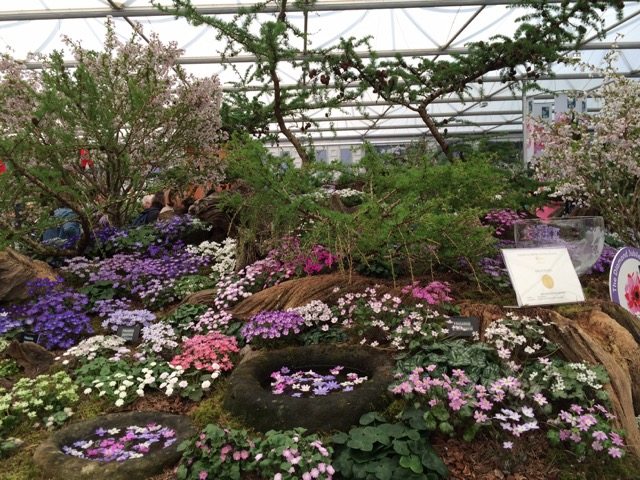 Laid out behind the vendors’ alley way in colorful squares outdoors, and inside the huge tent in the center of the grounds, were hundreds of gardens, each with a different theme. One of the most eye catching was not actually made up of live flowers, but was a massive carpet of knitted red poppies lining the steps that led from the Royal Hospital to the garden grounds.
Laid out behind the vendors’ alley way in colorful squares outdoors, and inside the huge tent in the center of the grounds, were hundreds of gardens, each with a different theme. One of the most eye catching was not actually made up of live flowers, but was a massive carpet of knitted red poppies lining the steps that led from the Royal Hospital to the garden grounds.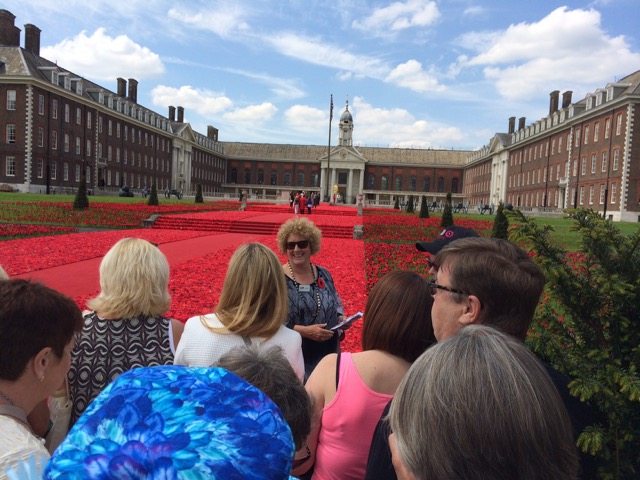 Pensioners decked out in red uniforms marched proudly along it, and mingled with the crowd, often graciously agreeing to have their pictures taken with onlookers.
Pensioners decked out in red uniforms marched proudly along it, and mingled with the crowd, often graciously agreeing to have their pictures taken with onlookers.
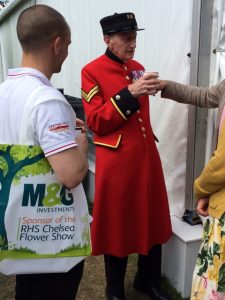 Who were these Chelsea Pensioners? The red poppies were a dead give-away to those of us from the British Commonwealth or the UK. Every year on November 11 we wear fuzzy red fabric poppies in our lapels to commemorate Armistice Day (Veteran’s Day in the US).
Who were these Chelsea Pensioners? The red poppies were a dead give-away to those of us from the British Commonwealth or the UK. Every year on November 11 we wear fuzzy red fabric poppies in our lapels to commemorate Armistice Day (Veteran’s Day in the US).
The poppy symbol comes from the poem “In Flanders fields where poppies blow, between the crosses row on row…” written on the battlefield in World War I. Every day, as a medical student and intern, I walked by a plaque in the entrance hall of Montreal’s Royal Victoria Hospital, memorializing that poem and the Canadian physician-poet who wrote it, John McCrae.
The Chelsea Pensioners are war veterans of the British Army, who live out their retirement at the Royal Hospital in Chelsea. To my astonishment, this red brick set of buildings had been commissioned by King Charles II in 1681 to care for those ‘broken by age or war.” That was sixty-one years after the Mayflower landed in Virginia and ninety-five years before the American Revolution! It was entirely possible that some of those Red Coats whom the Revolutionaries had fought spent their final years at the Royal Hospital Chelsea.
Then, unlike its busy urban setting now, Chelsea was a bucolic countryside by the Thames. It was meant as a place of respite for these proud soldiers, honored by their King. In fact, he commissioned the greatest architect of the day to design the place – Sir Christopher Wren, who also designed St. Paul’s Cathedral in London.
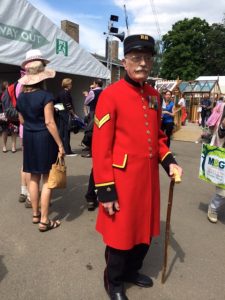 The men I saw did not seem broken by war – most veterans of World War II, they wore their uniforms with pride and held their heads high, chatting with the thousands of visitors to their home.
The men I saw did not seem broken by war – most veterans of World War II, they wore their uniforms with pride and held their heads high, chatting with the thousands of visitors to their home.
It reminded me how gardens can indeed help heal, even wounds of war. At the Walter Reed National Military Medical Center in Bethesda, Maryland, we are working with the US Navy, The Institute for Integrative Health, and the TKF Foundation to create a “Green Road” – a retrofitted branch of the Rock Creek that courses through this military base, to provide a place of quiet respite and contemplation for wounded warriors of US wars.
Hopefully when complete, that forest glen will have the same effect on Americans wounded by war, as the Chelsea Flower show seemed to have on the veterans of Britain’s wars.
To be continued….
Chelsea Flower Show, Part 1
On my way into town from Heathrow Airport, the taxi passed parades of ladies and gentlemen dressed as if in a British television series – men in frock coats, top hats, or suits, and ladies wearing hats. There were large pastel-colored fine straw hats and little ones trimmed with feathers and netting, perched on ladies’ heads at coquettish angles.As we approached my hotel in the St. James District of London, more and more elegant people appeared. They all seemed to be streaming in the same direction – towards us and away from Buckingham Palace.
Upon my questioning, my London cabbie said “Those would be the Queen’s Garden Party guests – a few times a year she invites people from all over Britain who’ve done good.” He explained that these good people were now all leaving that event to find taxis for themselves. He would clearly have no trouble replacing me when he dropped me off.
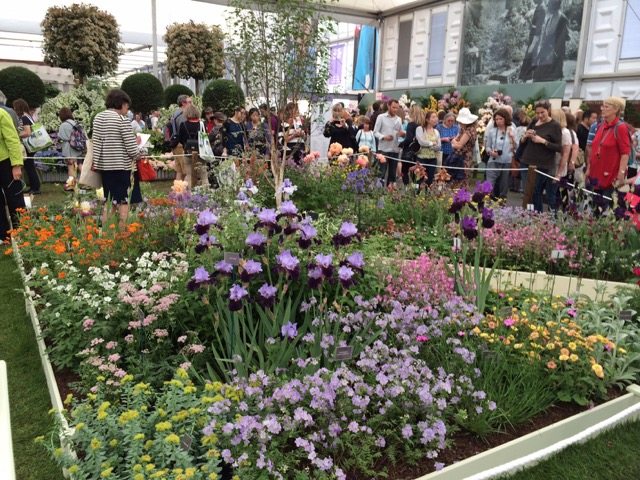 He went on to tell me that if I wanted to see more like this, I should attend the Chelsea Flower Show. It was opening that week at the Royal Hospital Chelsea, and the proceeds from the show would go to support the “Chelsea Pensioners” who live there. He warned me however not to take a cab – the traffic would be terrible. “Best way to get there is on foot,” he said – “only about a mile and half from your hotel.“
He went on to tell me that if I wanted to see more like this, I should attend the Chelsea Flower Show. It was opening that week at the Royal Hospital Chelsea, and the proceeds from the show would go to support the “Chelsea Pensioners” who live there. He warned me however not to take a cab – the traffic would be terrible. “Best way to get there is on foot,” he said – “only about a mile and half from your hotel.“
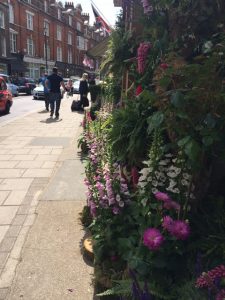 Although I was in London to attend the John Templeton Foundation’s Prize ceremony honoring Rabbi Lord Jonathan Sacks, I did have a day of down time, so I decided to go. The hotel Concierge managed to obtain a ticket for me, and I set out the next day to explore the event.
Although I was in London to attend the John Templeton Foundation’s Prize ceremony honoring Rabbi Lord Jonathan Sacks, I did have a day of down time, so I decided to go. The hotel Concierge managed to obtain a ticket for me, and I set out the next day to explore the event.
It was a delightful sunny spring day – perfect for a walk. On my way, I passed a couple of Palace Guards crossing the street for the Changing of the Guards, and knew definitively that I was in London.
As I approached the Royal Hospital, the Chelsea shops along the route seemed to be having their own flower show – competitions for whose window and sidewalk displays could be more festooned with their own creative gardens. 
I knew I was very close when I saw, snaking along the sidewalk, the long line of people waiting to enter. Ticket in hand, I plunged into the crowd. We found ourselves funneled into a long alley way lined on both sides with booths selling every manner of flowered item – scarves, hand-bags, fine china, umbrellas, hats, and of course gardening equipment. At the entrance was an ice cream stand and beyond were the food vendors.
Like me, the visitors were dressed much more casually than the crowd leaving Buckingham Palace. It seems that the Royals and VIPs had been there the day before the show opened to the public. In Britain the Royals take their philanthropic events very seriously, and this one, it turned out, was one of their biggest.
But who were the Chelsea Pensioners? And how was this Royal Hospital different from so many other hospitals? Why all the fuss?
To be continued…